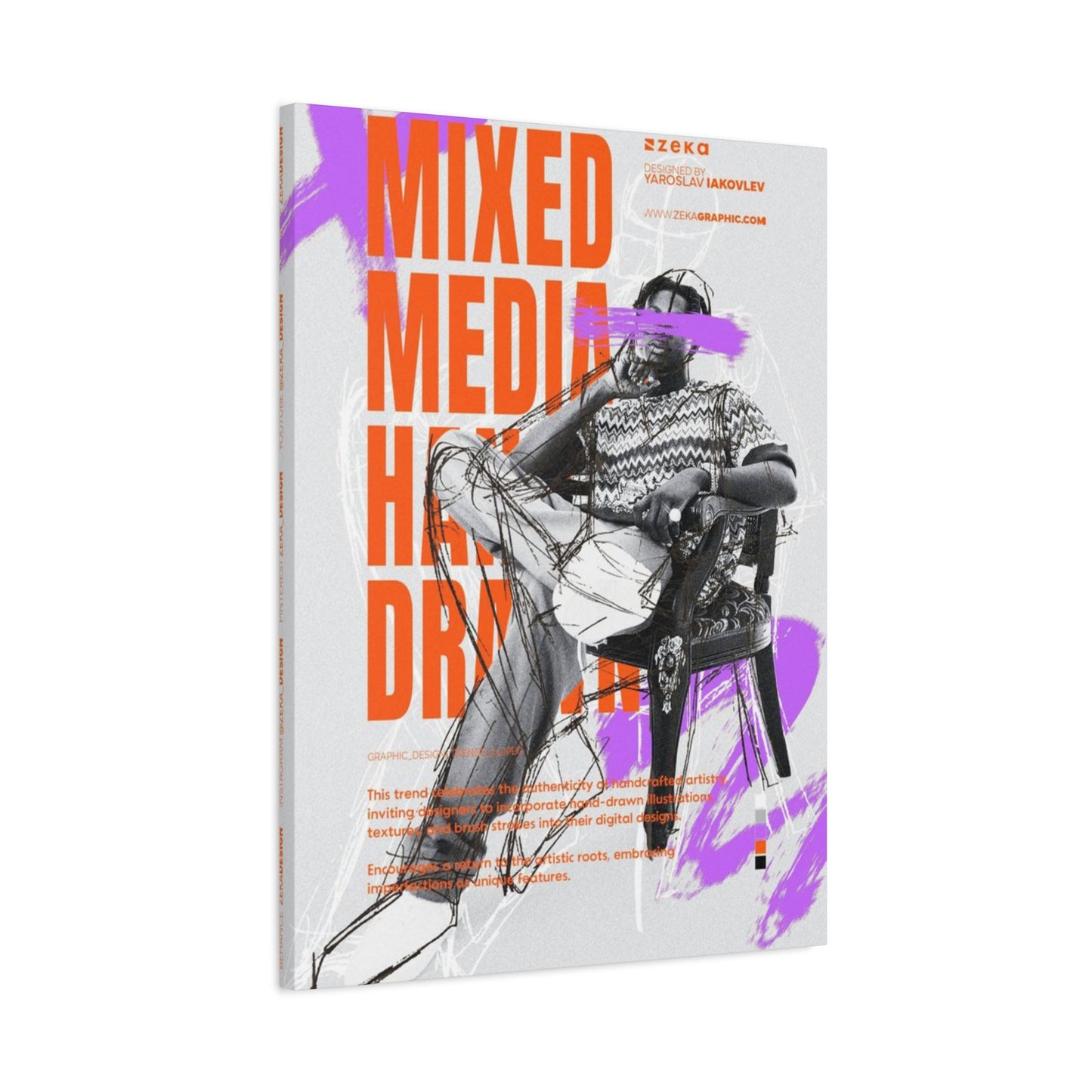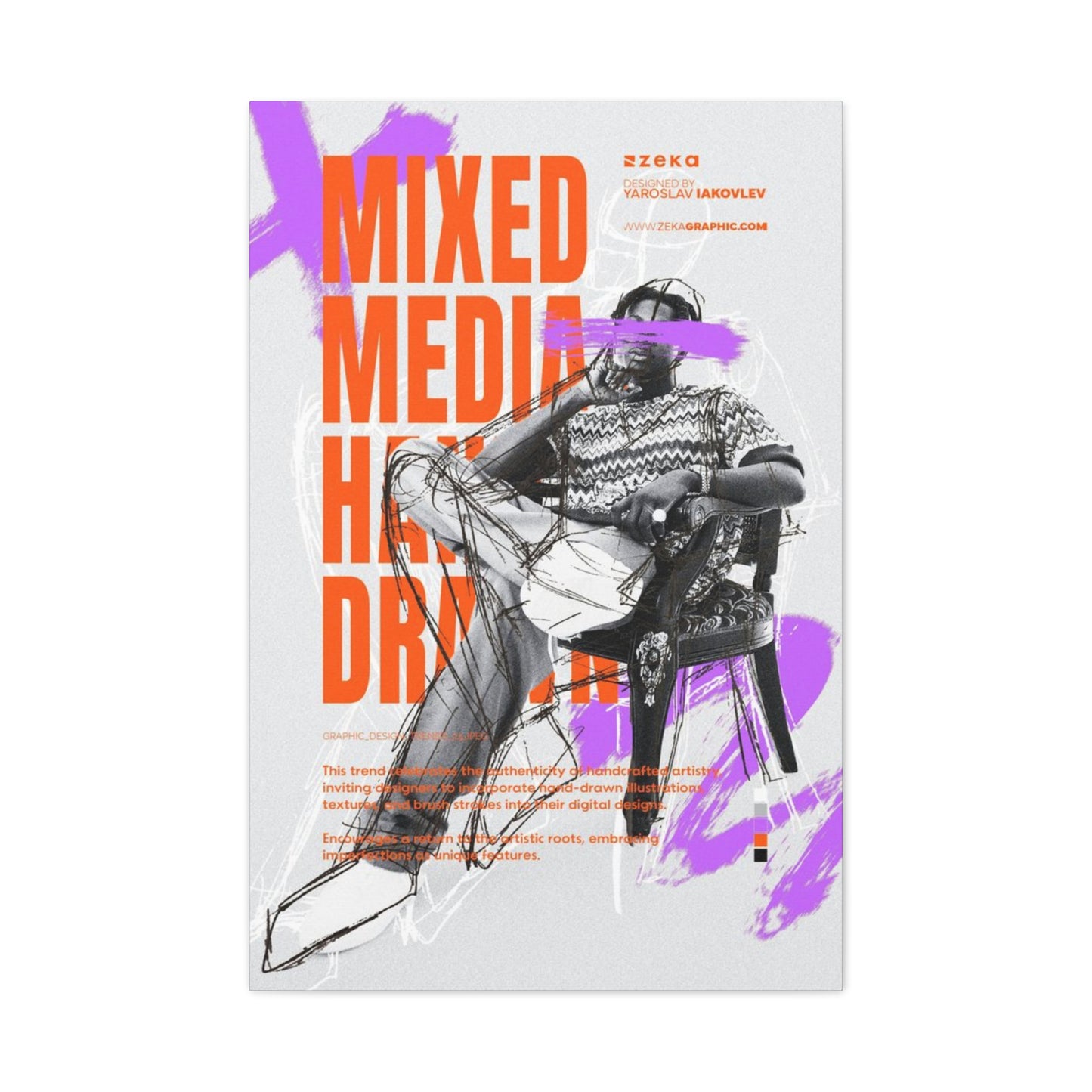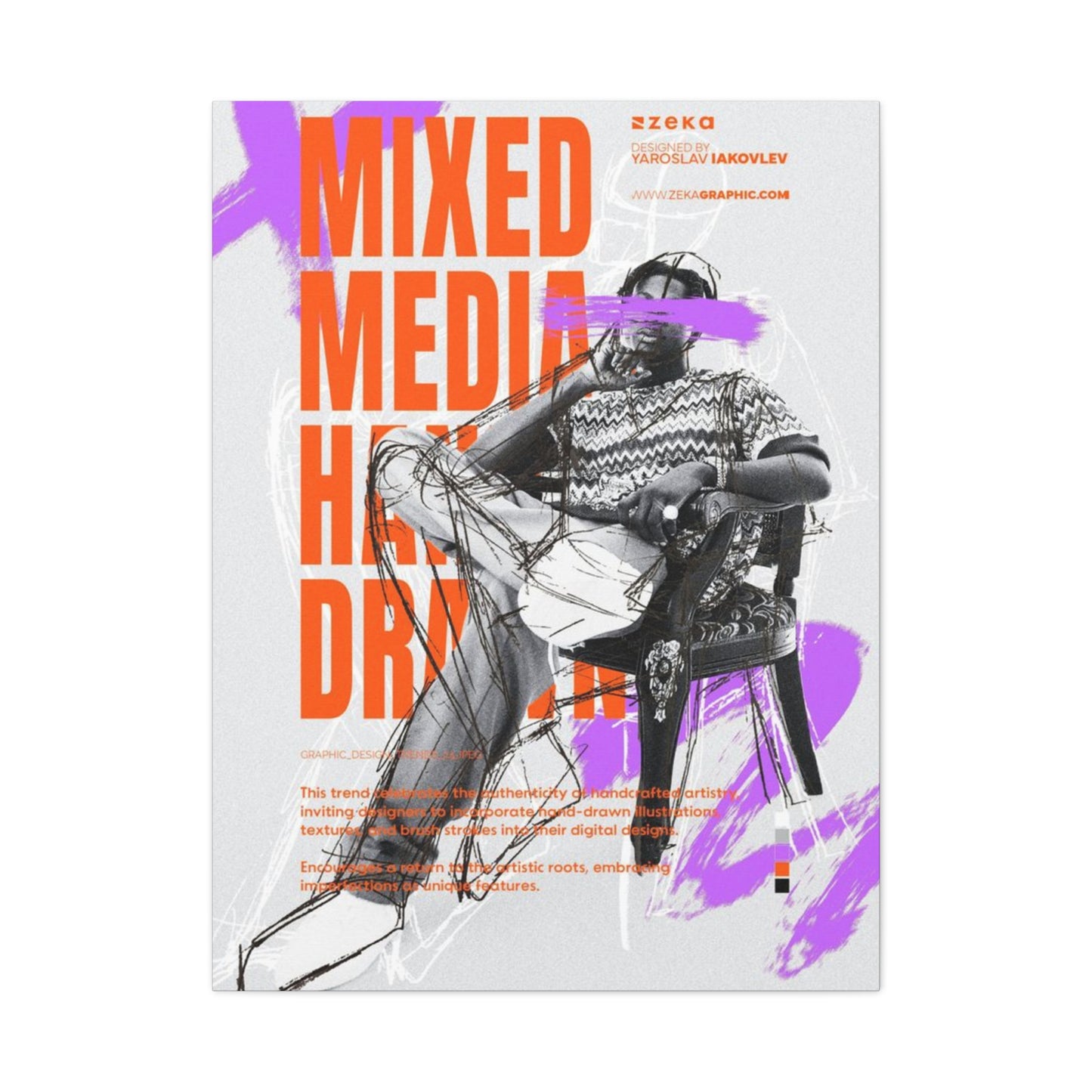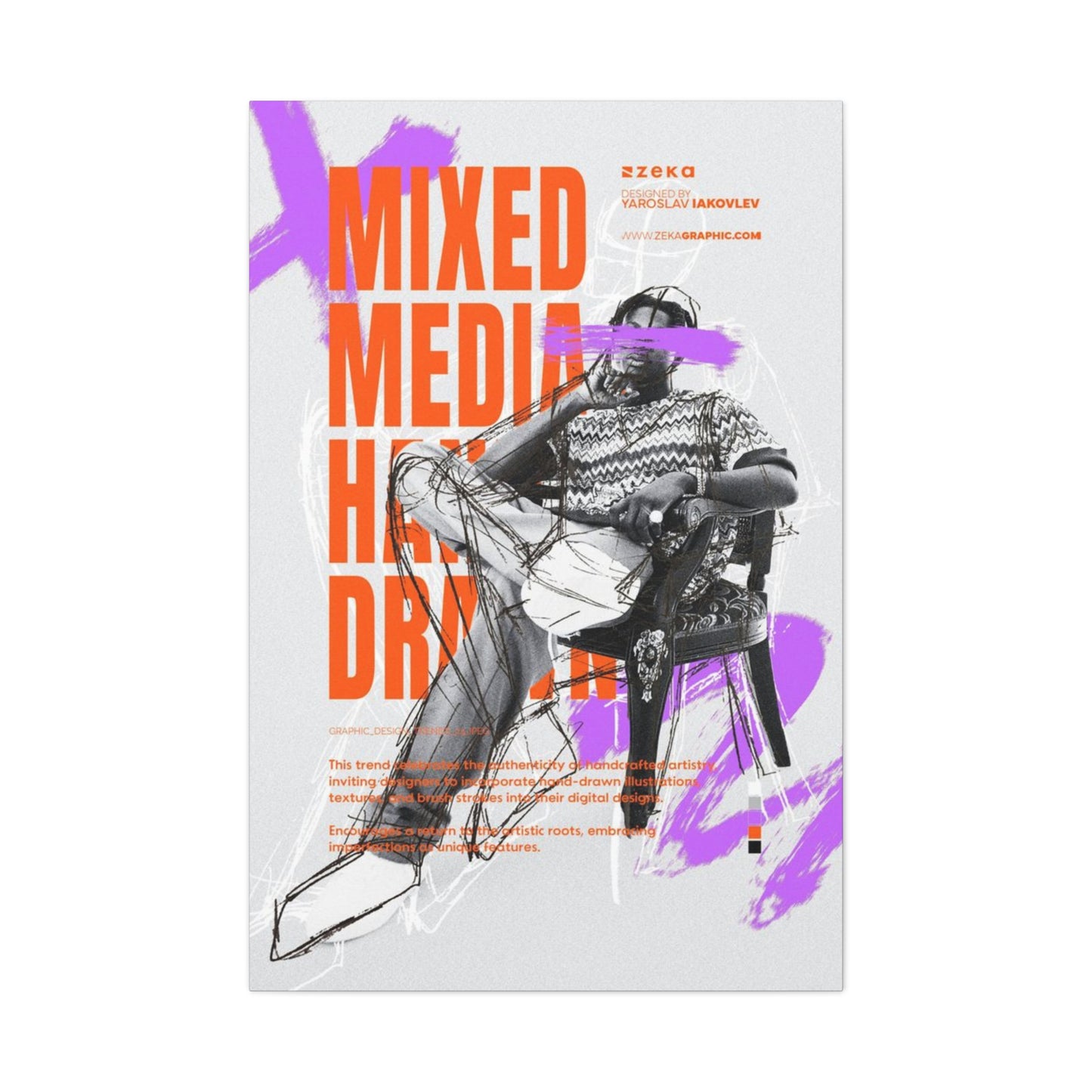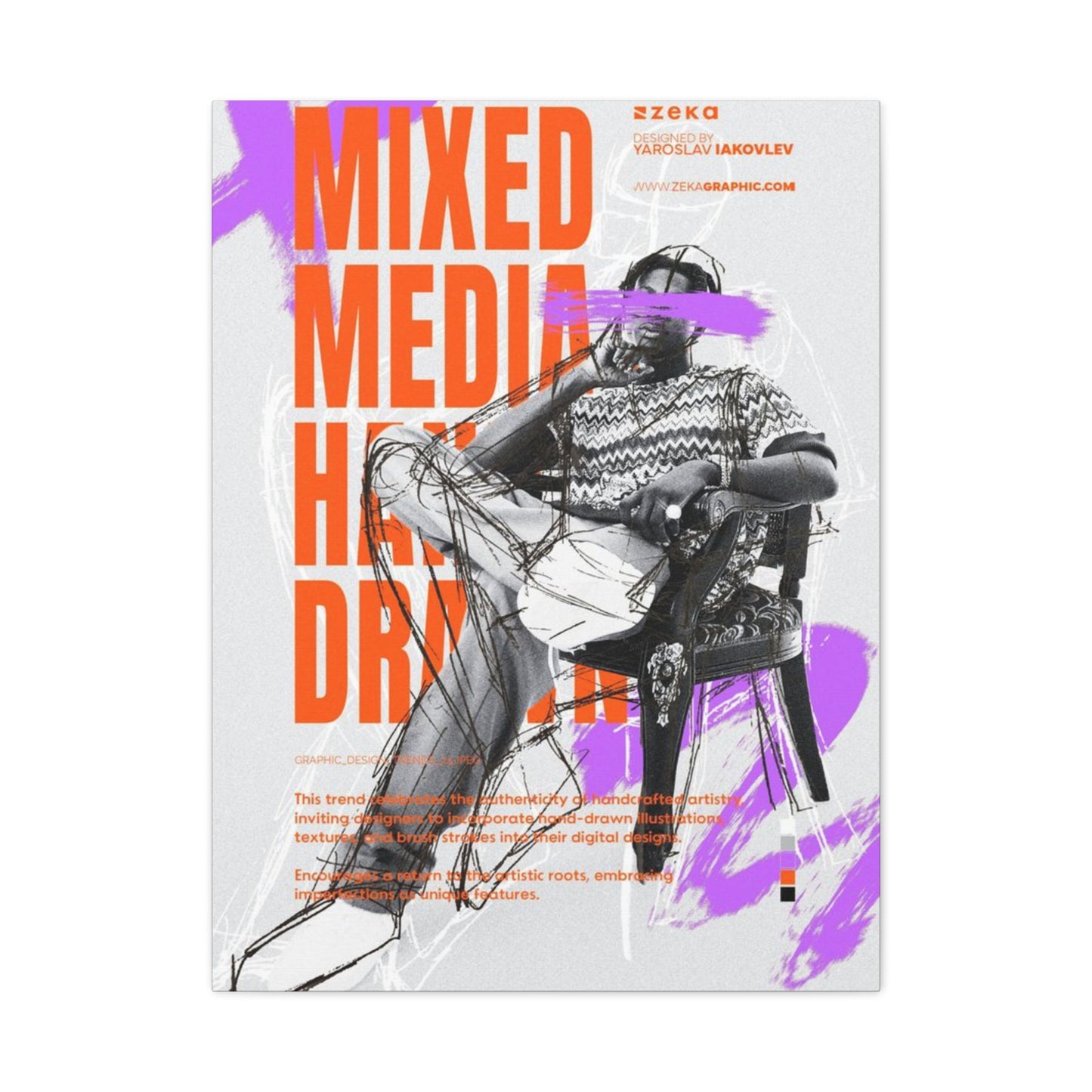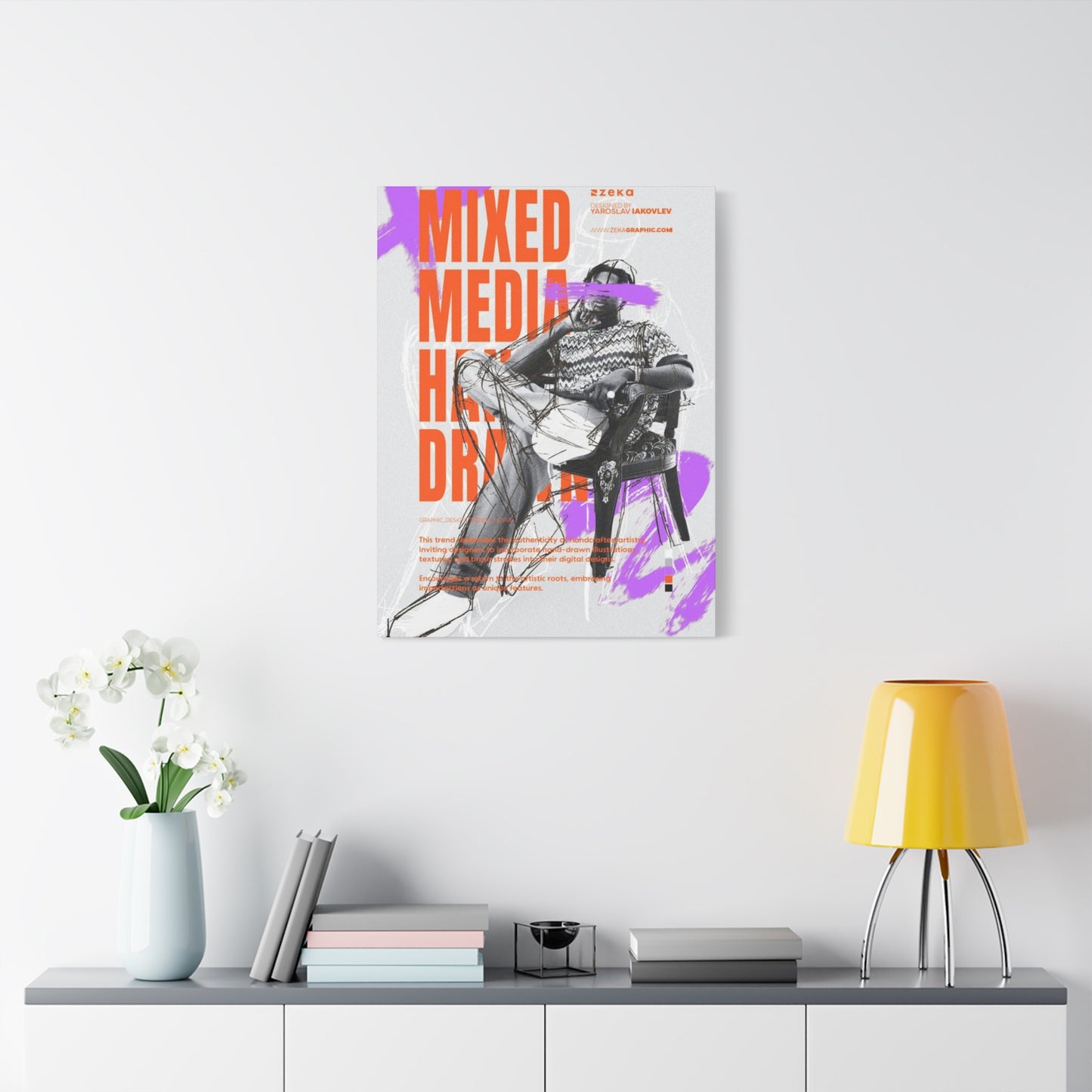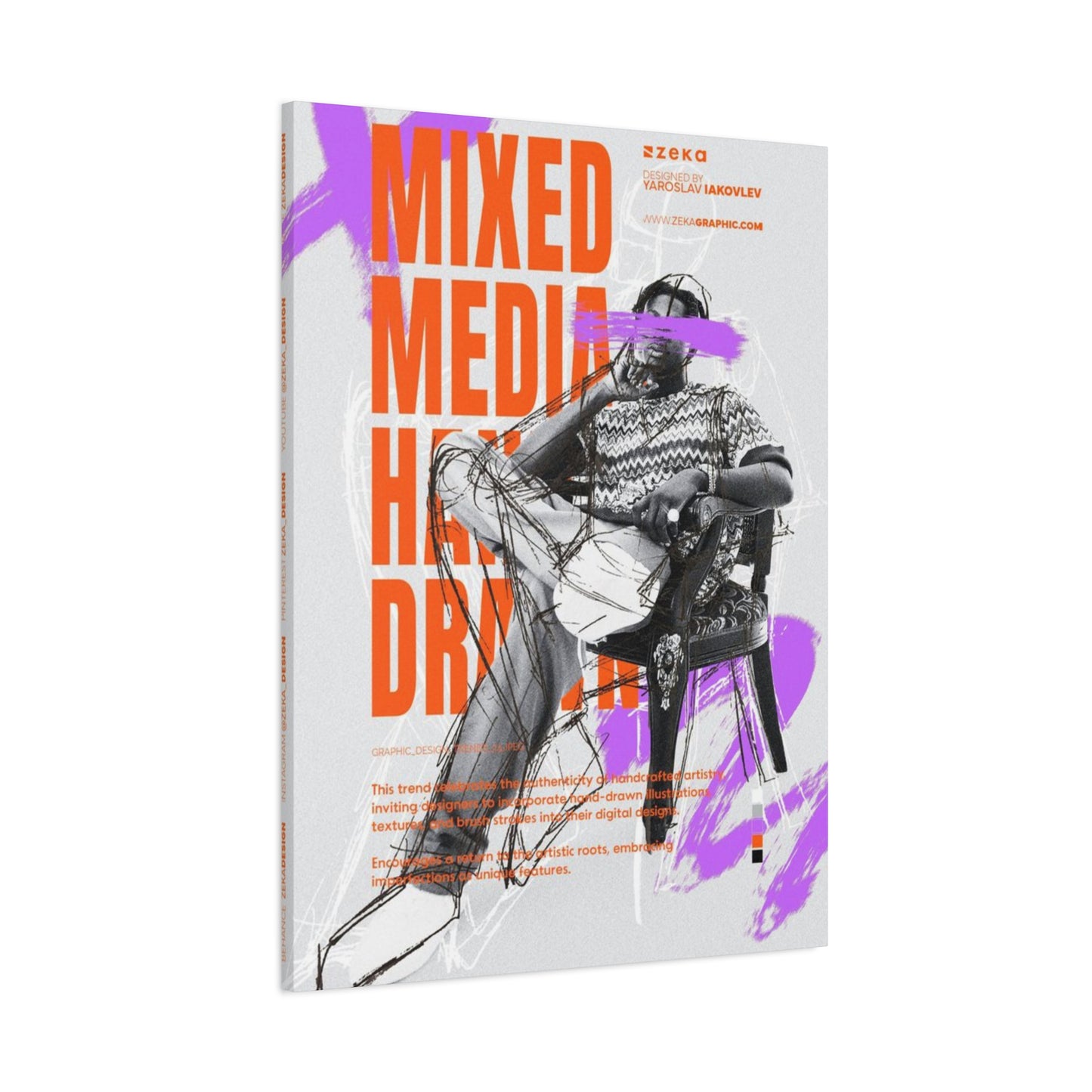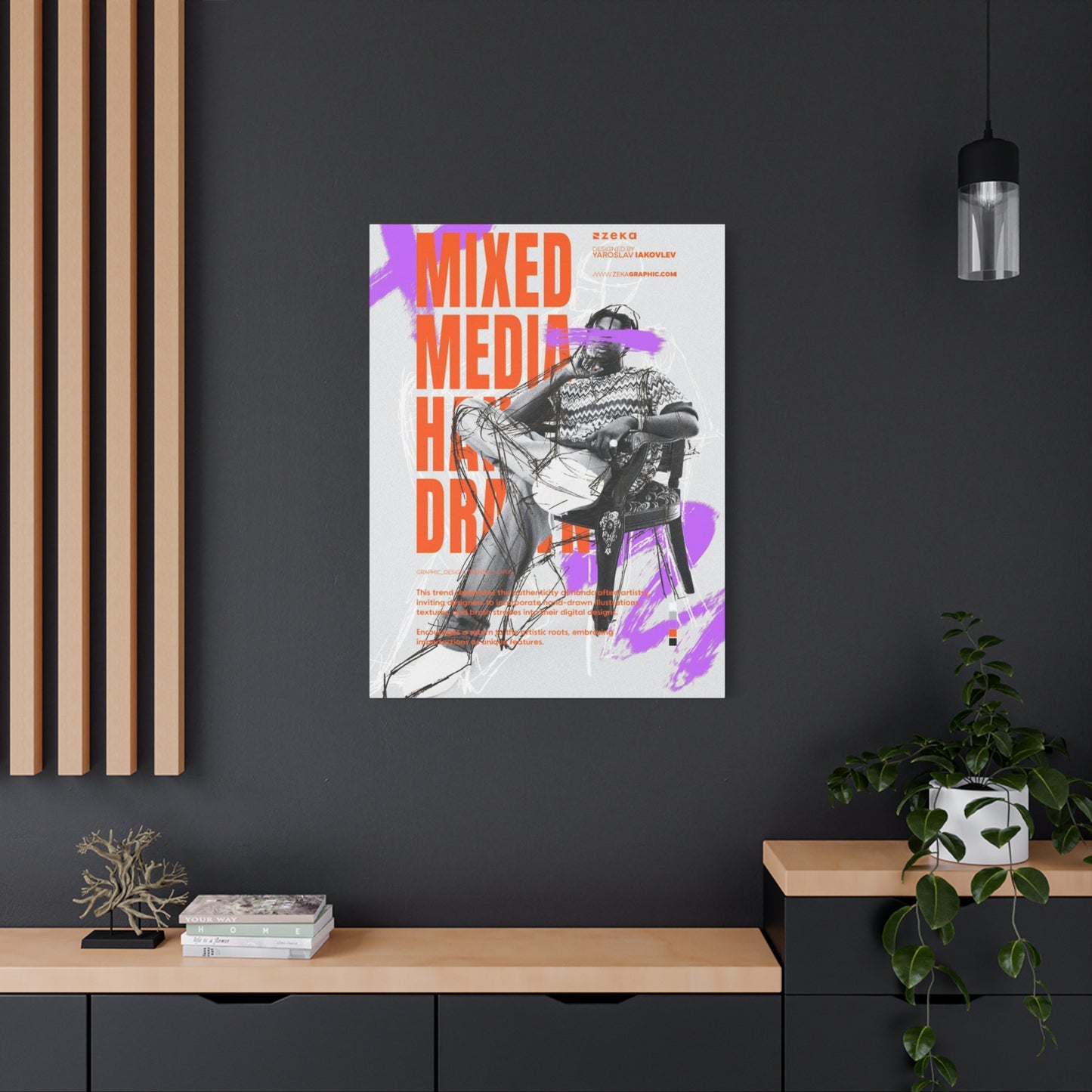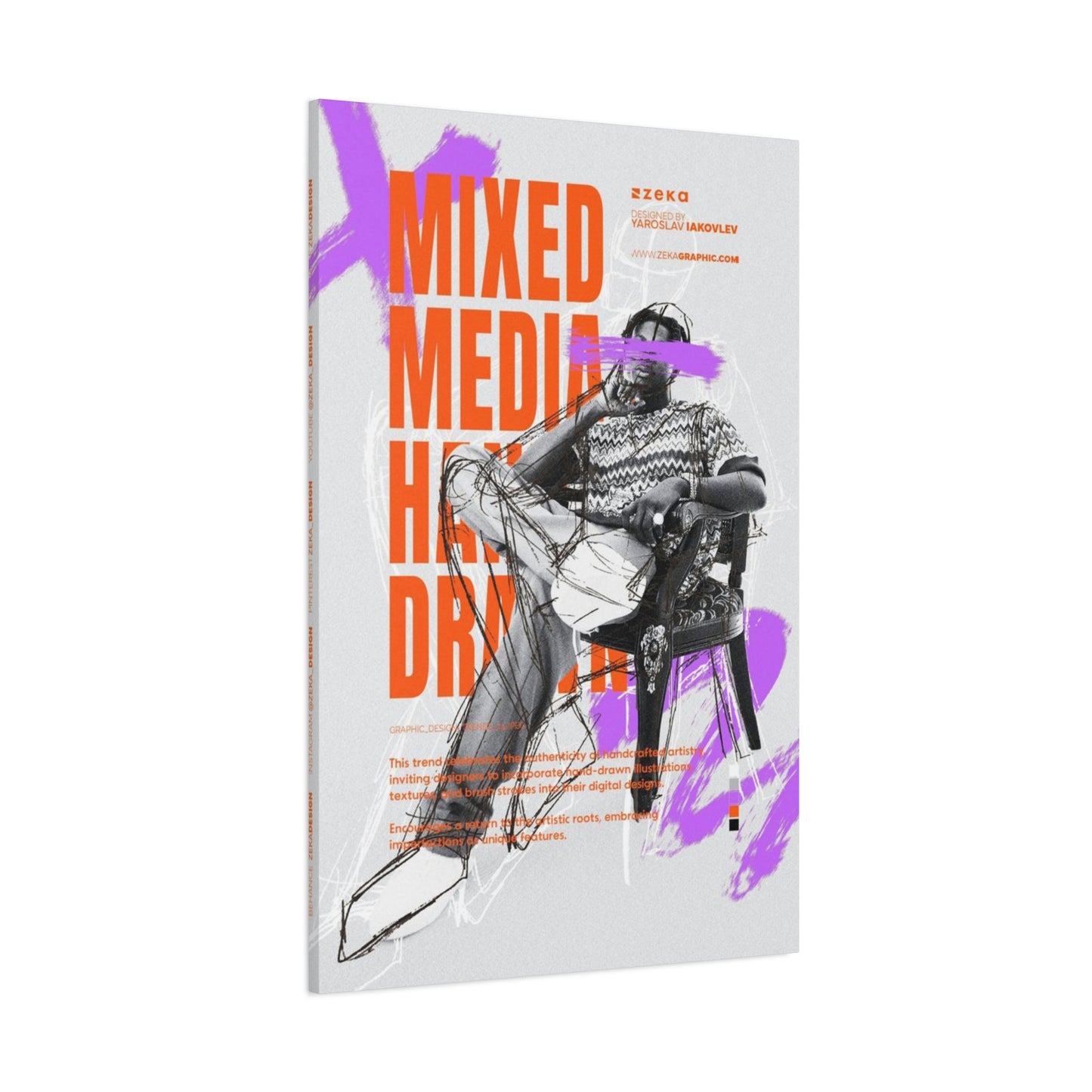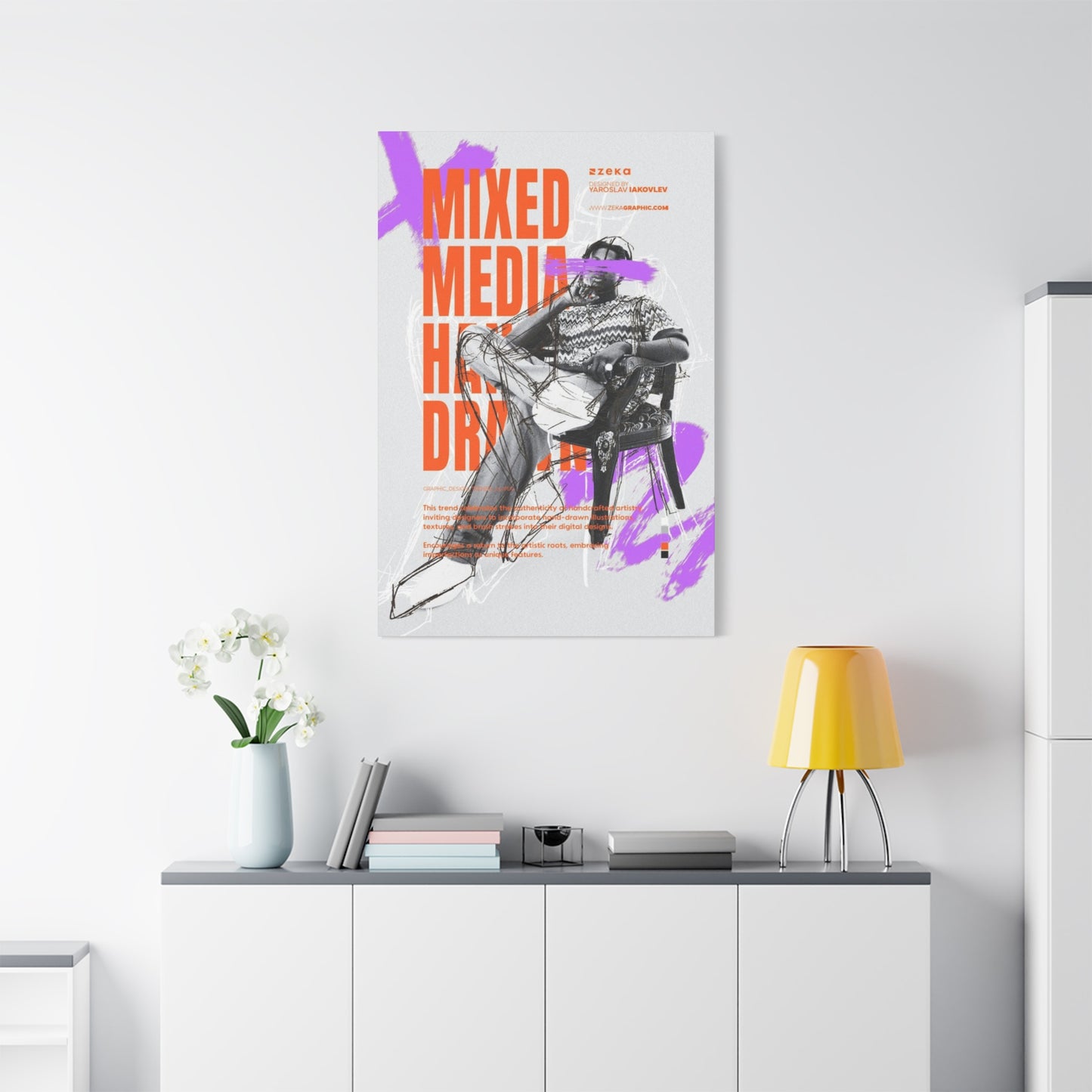Mixed Media Wall Art Canvas Prints: Creative Expression Through Artistic Innovation
Mixed media wall art canvas prints represent one of the most dynamic and versatile forms of contemporary artistic expression available today. These innovative artworks combine multiple artistic techniques, materials, and mediums to create visually stunning pieces that captivate viewers and transform any environment. The fusion of traditional painting methods with modern printing technologies, textural elements, and diverse materials has revolutionized how we approach decorative artwork for residential and commercial settings.
The popularity of mixed media wall art has surged dramatically in recent years, driven by artists' desire to break free from conventional boundaries and explore new creative possibilities. By incorporating various materials such as fabric, paper, metal, wood, glass, and digital elements, artists can create layered compositions that offer depth, texture, and visual interest far beyond what traditional single-medium artwork can achieve.
Canvas prints have become the preferred foundation for mixed media artwork due to their durability, versatility, and ability to showcase intricate details and vibrant colors. The canvas material provides an ideal surface that can support multiple layers of media while maintaining structural integrity. Modern printing technologies ensure that every nuance of the original mixed media artwork is faithfully reproduced, allowing art enthusiasts to enjoy museum-quality reproductions in their homes and offices.
Revolutionary Techniques in Mixed Media Artistry
Mixed media artistry encompasses an incredible range of techniques that artists employ to create unique and compelling visual experiences. The combination of traditional painting methods with unconventional materials opens up endless possibilities for creative expression. Artists working in this medium often begin with a base layer using acrylic or oil paints, then build upon this foundation by incorporating collage elements, found objects, textural mediums, and digital components.
Layering is perhaps the most fundamental technique in mixed media art creation. Artists carefully build up multiple layers of different materials, each contributing to the overall composition while creating depth and visual complexity. This process requires careful planning and execution, as each layer must harmoniously interact with the others while maintaining the artwork's structural integrity.
Texture application represents another crucial aspect of mixed media techniques. Artists utilize various materials and tools to create tactile surfaces that engage viewers both visually and emotionally. Sand, gel mediums, modeling paste, fabric pieces, and natural materials like leaves or bark can be incorporated to add dimensional elements that photographs and traditional paintings cannot achieve.
Collage integration allows artists to incorporate paper elements, photographs, magazine clippings, sheet music, maps, and other printed materials into their compositions. These elements often serve as symbolic components that enhance the artwork's narrative or thematic content while contributing to the overall visual impact.
Digital manipulation has become increasingly important in contemporary mixed media art. Artists can scan, photograph, or digitally create elements that are then printed and incorporated into their physical artworks. This hybrid approach bridges the gap between traditional and digital art forms, creating unique pieces that reflect our increasingly connected world.
Color blending techniques in mixed media art often involve combining transparent and opaque materials to create complex color relationships. Artists might use watercolor washes over acrylic textures, or apply transparent glazes over collaged elements to unify the composition while maintaining the distinct character of each component.
Essential Materials for Mixed Media Canvas Creation
The world of mixed media art materials is vast and constantly expanding as artists discover new ways to incorporate everyday objects and specialized art supplies into their creative process. Understanding the properties and potential applications of various materials is crucial for both artists and collectors who appreciate this dynamic art form.
Acrylic paints serve as the backbone of most mixed media compositions due to their versatility, quick drying time, and ability to adhere to almost any surface. These paints can be mixed with various mediums to alter their consistency, texture, and finish, making them ideal for creating base layers, detailed work, and textural elements within the same piece.
Gel mediums and modeling compounds provide artists with the ability to create three-dimensional elements and textural surfaces. Heavy gel mediums can hold lightweight objects in place while adding body to paint, while modeling paste allows for the creation of raised, sculptural elements that cast shadows and create visual interest through dimensional variation.
Paper materials form a crucial component of mixed media artwork. Artists utilize everything from handmade papers and vintage book pages to contemporary specialty papers with unique textures and finishes. The choice of paper can significantly impact the artwork's overall aesthetic and historical or cultural references.
Fabric elements bring softness, texture, and often cultural significance to mixed media compositions. Lace, burlap, silk, canvas scraps, and specialized art fabrics can be adhered to the canvas surface using appropriate adhesives, creating tactile contrast with painted and printed elements.
Natural materials such as sand, shells, dried flowers, leaves, twigs, and stones connect mixed media artwork to the natural world while adding authentic texture and organic shapes that cannot be replicated through artificial means. These materials must be properly prepared and sealed to ensure longevity in the finished artwork.
Metal components including wire, mesh, foil, and small found objects can add industrial or contemporary elements to mixed media pieces. These materials often require special adhesives or mounting techniques but provide unique reflective properties and structural elements that enhance the artwork's visual impact.
Adhesives and sealers play a critical role in mixed media art creation, as they must bond diverse materials while remaining invisible and maintaining flexibility over time. Artists must choose appropriate products for each material combination to ensure the artwork's longevity and stability.
Canvas Selection and Preparation Methods
The choice of canvas foundation significantly impacts the success of mixed media wall art projects. Different canvas types, weights, and preparations offer varying advantages depending on the specific materials and techniques the artist plans to employ. Understanding these differences helps ensure optimal results and artwork longevity.
Canvas weight and weave density affect how well the surface will support heavy media applications and detailed work. Heavier canvases with tighter weaves provide more stability for dimensional elements and extensive layering, while lighter canvases may be suitable for projects with minimal texture and weight.
Priming and ground preparation create the foundation for all subsequent layers in mixed media artwork. Traditional gesso provides a neutral, slightly textured surface that accepts most media well, while specialized primers can be chosen to enhance specific effects or improve adhesion for particular materials.
Surface texture considerations influence both the application of materials and the final visual result. Smooth surfaces allow for precise detail work and clean color application, while textured surfaces can enhance the organic, handmade quality that many mixed media artists seek to achieve.
Canvas stretching and mounting must be performed with extra attention to stability when working with mixed media techniques. The additional weight and dimensional elements require sturdy stretcher bars and proper tension to prevent sagging or warping over time.
Pre-planning the composition on canvas helps artists organize their material application sequence and ensure proper layering order. This planning phase is particularly important in mixed media work, where changes become increasingly difficult as layers accumulate.
Quality considerations in canvas selection directly impact the finished artwork's appearance and longevity. Professional-grade canvases resist yellowing, maintain proper tension, and provide consistent surfaces that showcase mixed media elements to their best advantage.
Color Theory Applications in Mixed Media Art
Color theory principles take on added complexity in mixed media artwork due to the interaction between various materials, each with its own optical properties. Understanding how colors behave when layered, mixed, and combined with textural elements enables artists to create more sophisticated and visually impactful compositions.
Transparency and opacity relationships become particularly important when working with multiple media types. Transparent materials allow underlying layers to show through, creating depth and complexity, while opaque materials can be used to create focal points and visual anchors within the composition.
Color temperature interactions help create mood and atmosphere in mixed media pieces. Warm colors tend to advance visually while cool colors recede, and this principle can be enhanced or contradicted through the strategic use of textural elements and dimensional components.
Complementary color schemes gain added drama when implemented through mixed media techniques. The contrast between complementary colors can be enhanced through textural differences, with smooth surfaces appearing to advance and textured surfaces creating visual interest through shadow and highlight variations.
Monochromatic approaches in mixed media art rely heavily on texture and material variation to create visual interest. By limiting the color palette, artists can focus attention on the interplay between different materials and surface treatments while maintaining compositional unity.
Analogous color harmonies create peaceful, cohesive mixed media compositions that rely on subtle color variations and material contrasts to maintain visual engagement. These color schemes often work well in residential settings where harmony and tranquility are desired.
Color psychology considerations influence how viewers respond emotionally to mixed media artwork. The choice of color palette, combined with specific materials and textures, can evoke particular moods or memories, making color selection a powerful tool for artistic communication.
Textural Elements and Three-Dimensional Components
Texture serves as one of the most distinctive characteristics of mixed media wall art, differentiating it from traditional flat artwork and creating engaging tactile and visual experiences. The strategic use of textural elements can guide viewer attention, create emphasis, and add emotional depth to artistic compositions.
Raised texture applications using gel mediums, modeling paste, and impasto techniques create actual three-dimensional surfaces that cast shadows and catch light differently throughout the day. These elements add dynamism to the artwork as changing light conditions reveal new details and aspects of the composition.
Embedded object integration involves incorporating three-dimensional items directly into the artwork surface. These objects must be carefully chosen and positioned to enhance rather than distract from the overall composition while ensuring they remain securely attached over time.
Surface variation techniques include sanding, carving, and buildup methods that create subtle to dramatic changes in the canvas surface. These variations can be used to suggest landscape features, architectural elements, or abstract forms that enhance the artwork's thematic content.
Fabric texture incorporation brings softness and familiarity to mixed media compositions. The way fabric responds to light and shadow adds organic variation that complements harder, more geometric elements within the same piece.
Natural texture integration through materials like sand, bark, or stone connects the artwork to the natural world while providing authentic textural experiences that cannot be replicated artificially. These materials must be properly sealed to prevent deterioration while maintaining their distinctive characteristics.
Layered texture building involves applying multiple textural elements in sequence, allowing each layer to interact with and modify the others. This technique requires patience and planning but can result in incredibly rich and complex surface treatments.
Digital Integration and Modern Printing Technologies
Contemporary mixed media wall art increasingly incorporates digital elements, taking advantage of advanced printing technologies that can reproduce fine details, subtle color gradations, and complex compositions with remarkable accuracy. This integration of digital and physical elements represents the evolution of traditional mixed media techniques for the modern era.
High-resolution scanning allows artists to capture and manipulate photographic elements, hand-drawn components, or existing textures for incorporation into their mixed media compositions. These digital elements can be scaled, colored, and modified before being printed onto various substrates for physical integration.
Digital painting and drawing elements created using professional software can be seamlessly combined with traditional media, allowing artists to achieve effects that would be difficult or impossible using only physical materials. These digital components can be printed with archival inks for long-lasting integration into mixed media pieces.
Layered printing techniques enable artists to build up printed elements in multiple passes, creating density and complexity that rivals hand-painted work. Different ink types and printing methods can be combined to achieve specific textural and visual effects.
Color matching between digital and physical elements requires careful calibration and testing to ensure seamless integration. Professional color management systems help artists achieve consistent results when combining printed and hand-painted components.
Substrate variety in digital printing opens up numerous possibilities for mixed media integration. Elements can be printed on paper, fabric, metal, plastic, or specialty materials, each offering different textural and visual properties for incorporation into the final artwork.
Archival considerations in digital printing ensure that digitally integrated elements maintain their quality and appearance over time. The use of archival inks and papers helps guarantee that mixed media artworks will remain stable and attractive for decades.
Printing Quality and Canvas Reproduction Techniques
The reproduction of mixed media artwork as canvas prints requires sophisticated understanding of color management, resolution requirements, and printing technologies to accurately capture the complexity and nuance of the original pieces. Modern canvas printing has reached levels of quality that allow viewers to experience much of the visual impact of original mixed media artwork.
Resolution requirements for mixed media reproduction are typically higher than those needed for traditional paintings due to the fine details present in textural elements and collaged components. High-resolution scanning or photography of original artworks ensures that subtle details are preserved in the printed reproduction.
Color calibration processes must account for the complex color interactions present in mixed media artwork. Professional color management systems ensure that the printed canvas accurately represents the colors and tonal relationships present in the original piece.
Canvas material selection affects both the appearance and longevity of printed reproductions. Different canvas weaves and treatments can enhance or detract from the reproduction's ability to capture the character of the original mixed media artwork.
Ink technology choices impact color accuracy, longevity, and the ability to reproduce subtle tonal variations. Pigment-based inks generally provide better longevity and color accuracy than dye-based alternatives, making them preferred for high-quality mixed media reproductions.
Printing process variations including giclee, digital, and hybrid techniques each offer different advantages for reproducing mixed media artwork. The choice of printing method should align with the characteristics of the original artwork and the intended display environment.
Post-printing treatments such as protective coatings, texture enhancement, or hand-finishing can improve the reproduction's resemblance to the original mixed media piece while providing additional protection against environmental factors.
Historical Evolution of Mixed Media Art
Mixed media art has roots stretching back centuries, though the formal recognition and development of the medium has accelerated dramatically in recent decades. Understanding this historical context helps appreciate the innovation and creativity that contemporary mixed media artists bring to their work.
Early collage experiments by artists like Pablo Picasso and Georges Braque in the early 20th century laid groundwork for modern mixed media techniques. Their incorporation of newspaper clippings, fabric, and other materials into painted compositions challenged traditional notions of what constituted fine art.
Pop art movement contributions in the 1950s and 1960s further expanded mixed media possibilities as artists like Robert Rauschenberg and Jasper Johns incorporated found objects, photographs, and commercial materials into their artworks. These artists demonstrated that everyday materials could be elevated to fine art status through creative application.
Contemporary developments in mixed media art have been influenced by technological advances, changing cultural attitudes, and increased access to diverse materials. Artists today have unprecedented freedom to experiment with combinations of traditional and modern materials.
Cultural influences on mixed media development vary globally, with different regions contributing unique materials, techniques, and aesthetic approaches. This diversity has enriched the medium and provided artists with an ever-expanding vocabulary of creative possibilities.
Institutional recognition of mixed media art by museums, galleries, and art schools has legitimized the medium and encouraged further experimentation. This recognition has also led to improved understanding of conservation and display requirements for mixed media artwork.
Future directions in mixed media art likely include further integration of digital technologies, new materials developed for artistic use, and continued exploration of the boundaries between different art forms and media.
Artistic Styles and Movement Influences
Mixed media wall art draws inspiration from numerous artistic movements and styles, creating a rich tapestry of approaches that artists can explore and combine. This diversity allows for personal expression while building upon established artistic traditions.
Abstract expressionism influences appear in mixed media work through gestural mark-making, emphasis on process, and emotional content. Artists working in this tradition often use mixed media techniques to enhance the expressive power of their gestures and mark-making.
Surrealism contributions to mixed media art include the incorporation of unexpected materials and juxtapositions that challenge rational thought. The surrealist tradition of automatic drawing and chance operations finds new expression through mixed media techniques.
Minimalism principles can be applied to mixed media art through careful material selection and restrained composition. Even when using multiple materials, artists can create clean, focused compositions that embody minimalist aesthetics.
Folk art traditions from various cultures provide rich sources of materials, techniques, and aesthetic approaches for contemporary mixed media artists. These traditions often emphasize handcraft, local materials, and cultural symbolism.
Contemporary street art and graffiti influences bring urban energy and social commentary to mixed media compositions. Techniques like stenciling, wheat pasting, and layered imagery translate effectively to gallery and residential settings.
Environmental and ecological concerns inspire mixed media artists to incorporate recycled materials, natural elements, and themes related to human impact on the environment. This approach often combines aesthetic goals with social and environmental messaging.
Composition Principles for Mixed Media Success
Creating successful mixed media wall art requires careful attention to composition principles that help organize diverse elements into coherent and visually compelling arrangements. These principles must be adapted to account for the complexity and variety inherent in mixed media work.
Balance considerations in mixed media composition must account for both visual weight and actual physical weight of different elements. Textural and dimensional components can dramatically affect perceived balance, requiring careful distribution throughout the composition.
Focal point creation becomes more complex when working with multiple materials and techniques. Artists must carefully orchestrate color, texture, contrast, and dimensional elements to guide viewer attention without creating visual chaos.
Movement and flow within mixed media compositions can be enhanced through the strategic placement of textural elements, color transitions, and directional components. The variety of materials available allows for subtle guidance of viewer eye movement through the piece.
Unity and variety principles help create compositions that hold together as complete statements while maintaining visual interest. The challenge in mixed media work lies in achieving unity despite the diversity of materials and techniques employed.
Scale relationships between different elements affect both the overall impact of the composition and the viewer's ability to read and understand individual components. Careful consideration of scale helps create hierarchies of importance within the artwork.
Rhythm and repetition can be established through repeated materials, colors, textures, or shapes distributed throughout the composition. This repetition helps create visual music that keeps viewers engaged while exploring the artwork.
Display Considerations and Environmental Factors
Mixed media wall art requires special consideration when it comes to display, as the variety of materials and techniques used can make these pieces more sensitive to environmental factors than traditional artwork. Proper display ensures both optimal viewing and long-term preservation.
Lighting requirements for mixed media art must account for textural elements that benefit from directional lighting to reveal their dimensional qualities. However, some materials may be sensitive to ultraviolet light, requiring filtered illumination or reduced light levels.
Humidity control becomes particularly important when mixed media artwork incorporates organic materials, papers, or fabrics that can respond to moisture changes. Stable humidity levels help prevent warping, mold growth, and material degradation.
Temperature stability protects both the artwork's structural integrity and its aesthetic appearance. Different materials expand and contract at different rates with temperature changes, potentially causing stress or damage in mixed media pieces.
Air quality considerations include protection from pollutants, dust, and other airborne contaminants that can accumulate on textured surfaces and cause gradual deterioration. Proper ventilation and filtration help maintain artwork condition.
Security concerns may be heightened for mixed media pieces that incorporate valuable materials or small dimensional elements that could be easily removed. Display locations should provide appropriate security while allowing proper viewing access.
Conservation requirements for mixed media art are often more complex than those for traditional artwork, as each material component may have different preservation needs. Professional conservation advice may be necessary for valuable pieces.
Color Psychology and Emotional Impact
The emotional impact of mixed media wall art is significantly enhanced by thoughtful color selection and the psychological associations that different colors evoke in viewers. Understanding these relationships helps artists and collectors choose pieces that will create desired emotional responses in their display environments.
Warm color palettes including reds, oranges, and yellows tend to create energizing, welcoming atmospheres that encourage social interaction and activity. These colors work well in gathering areas and places where stimulation and engagement are desired.
Cool color schemes featuring blues, greens, and purples promote calmness, reflection, and relaxation. These palettes are often preferred in private areas where peace and tranquility are valued over stimulation and energy.
Neutral color approaches using browns, grays, and earth tones provide sophisticated, timeless backgrounds that complement various decorative styles while allowing textural elements to take center stage. These palettes offer versatility and longevity in changing decorative environments.
Monochromatic color schemes create unity and sophistication while relying on texture and material variation to maintain visual interest. These approaches work well in contemporary settings where subtlety and refinement are preferred.
High contrast color combinations create drama and visual excitement but must be carefully balanced to avoid overwhelming viewers. The textural elements in mixed media art can help soften harsh color contrasts while maintaining visual impact.
Cultural color associations vary among different audiences and should be considered when creating or selecting mixed media artwork for specific settings. Colors that are positive in one culture may have different connotations in another.
Maintenance and Care Instructions
Proper maintenance and care of mixed media wall art ensures that these complex artworks retain their visual appeal and structural integrity over many years. The variety of materials typically incorporated requires understanding of different care requirements and potential problems.
Dust removal from mixed media artwork requires gentle techniques that won't disturb or damage delicate elements. Soft brushes, low-powered vacuums with brush attachments, and careful use of compressed air can help maintain clean surfaces without causing damage.
Handling procedures for mixed media pieces should minimize direct contact with artwork surfaces, as oils from hands can affect various materials differently. Clean cotton gloves provide protection when handling is necessary.
Environmental monitoring helps identify conditions that could threaten the artwork's stability. Simple devices can track temperature and humidity levels to ensure they remain within acceptable ranges for the materials present.
Professional cleaning may be required periodically, particularly for pieces displayed in high-traffic or dusty environments. Conservators familiar with mixed media techniques can safely clean complex pieces without causing damage.
Damage assessment and repair should be performed by professionals familiar with the specific materials and techniques used in the artwork. Improper repair attempts can cause additional damage or compromise the piece's artistic integrity.
Storage requirements for mixed media art include protection from physical damage, environmental extremes, and pest intrusion. Proper storage materials and methods help preserve artwork during periods when it's not displayed.
Investment Value and Market Considerations
Mixed media wall art represents a dynamic segment of the contemporary art market, with values influenced by factors including artist reputation, technical complexity, artistic innovation, and market demand. Understanding these factors helps collectors make informed decisions about acquisitions and care.
Artist reputation significantly impacts mixed media artwork value, with established artists commanding higher prices than emerging talents. However, the innovative nature of mixed media work means that new artists can gain recognition quickly through distinctive techniques or concepts.
Technical complexity and craftsmanship quality affect both immediate appeal and long-term value. Pieces that demonstrate exceptional skill in combining diverse materials and techniques often appreciate more rapidly than simpler works.
Rarity and uniqueness factors contribute to investment potential, as mixed media techniques often result in truly one-of-a-kind pieces that cannot be exactly replicated. This uniqueness can drive collector interest and value appreciation.
Market trends in mixed media art reflect broader cultural interests in sustainability, innovation, and personal expression. Artists who successfully tap into these trends may see increased demand for their work.
Condition preservation directly affects long-term value, making proper care and maintenance essential for collectors who view their acquisitions as investments. Well-preserved pieces retain and increase value more effectively than those showing deterioration.
Documentation and provenance records become particularly important for mixed media pieces, as the complexity of materials and techniques may require detailed information for authentication and conservation purposes.
Customization and Personalization Options
Mixed media wall art offers exceptional opportunities for customization and personalization, allowing collectors to commission pieces that reflect their specific preferences, memories, and aesthetic requirements. This personalization potential makes mixed media art particularly appealing for residential and commercial applications.
Commission processes for custom mixed media artwork typically involve detailed consultation between artist and client to establish themes, color preferences, size requirements, and material interests. This collaboration ensures that the finished piece meets the client's vision while maintaining artistic integrity.
Incorporation of personal materials allows clients to include meaningful objects, photographs, or documents in their commissioned artwork. These elements add personal significance while contributing to the piece's overall visual and textural composition.
Size and format flexibility in mixed media art enables creation of pieces that fit specific architectural requirements or display locations. Artists can adjust their techniques and material choices to accommodate various size constraints while maintaining artistic quality.
Color matching opportunities allow mixed media artists to work with existing decorative elements or color schemes while still creating distinctive and original artwork. This flexibility makes commissioned pieces more likely to integrate successfully into their intended environments.
Thematic development can reflect client interests, experiences, or cultural backgrounds, creating artwork that resonates personally while appealing to broader audiences. This personalization adds emotional value beyond the piece's aesthetic qualities.
Budget accommodation through material and technique choices allows artists to create satisfying mixed media pieces at various price points. Different materials and complexity levels can be adjusted to meet financial constraints without compromising artistic merit.
Contemporary Artists and Notable Examples
The contemporary mixed media art scene includes numerous talented artists whose innovative approaches and distinctive styles have helped establish the medium's reputation and expand its possibilities. Studying these artists' work provides insight into current trends and future directions.
Emerging artist recognition in mixed media often comes through social media exposure, gallery representation, and art fair participation. The visual appeal and photogenic nature of mixed media work makes it particularly suitable for online promotion and discovery.
Established artist innovations continue to push mixed media boundaries as experienced artists experiment with new materials, technologies, and concepts. These innovations often influence emerging artists and contribute to the medium's ongoing evolution.
International perspectives on mixed media art reveal cultural differences in material choices, techniques, and aesthetic preferences. This global diversity enriches the medium and provides inspiration for artists working in various cultural contexts.
Gallery representation for mixed media artists has increased as institutions recognize the commercial and artistic potential of the medium. This representation provides artists with professional support and collectors with quality assurance.
Museum collections increasingly include mixed media works, providing institutional validation and ensuring preservation of important pieces for future study. This institutional support helps establish the medium's place in art history.
Educational program development in art schools reflects growing interest in mixed media techniques among students and faculty. These programs help train the next generation of mixed media artists while advancing technical knowledge and artistic possibilities.
Educational Resources and Skill Development
Learning mixed media techniques requires access to quality educational resources that cover both technical skills and artistic development. The complexity of the medium makes structured learning particularly valuable for aspiring artists and art enthusiasts.
Workshop opportunities provide hands-on experience with mixed media techniques under expert guidance. These intensive learning experiences allow participants to experiment with materials and methods while receiving immediate feedback and instruction.
Online tutorial availability has expanded dramatically, offering convenient access to instruction from established mixed media artists around the world. Video tutorials are particularly effective for demonstrating complex layering and application techniques.
Book and publication resources provide detailed reference information on materials, techniques, and artistic approaches. Written resources complement hands-on learning by offering theoretical background and historical context.
Mentorship programs connect emerging artists with experienced practitioners who can provide personalized guidance and career advice. These relationships often prove invaluable for artistic and professional development.
Community art center classes make mixed media instruction accessible to broader audiences while fostering local artistic communities. These programs often emphasize enjoyment and personal expression over professional development.
University degree programs in mixed media or related fields provide comprehensive education that combines technical training with art history, criticism, and professional preparation. These programs prepare students for careers as artists, educators, or arts professionals.
Technology Integration and Future Developments
The integration of technology into mixed media art continues to evolve, opening new possibilities for artistic expression while challenging traditional boundaries between different media and art forms. Understanding these developments helps artists and collectors anticipate future trends and opportunities.
Digital tool integration includes software for planning compositions, manipulating photographic elements, and creating digital components for physical incorporation. These tools expand artists' capabilities while streamlining certain aspects of the creative process.
3D printing applications allow artists to create custom textural elements, sculptural components, and unique tools specifically designed for their artistic needs. This technology bridges digital design and physical creation in unprecedented ways.
Augmented reality possibilities enable mixed media artwork to incorporate digital layers that viewers can access through mobile devices. This technology adds interactive dimensions to traditional artwork while maintaining its physical presence.
Virtual reality applications for mixed media art include both creation tools that allow artists to design in three-dimensional virtual environments and viewing experiences that let audiences explore artwork in immersive settings.
Laser cutting and engraving technologies provide precise methods for creating custom stencils, cutting specialty papers, and engraving textural elements. These tools offer accuracy and repeatability that complement handmade elements.
Smart material incorporation includes color-changing pigments, conductive materials, and responsive elements that react to environmental conditions or viewer interaction. These materials add dynamic qualities to otherwise static artwork.
Market Analysis and Collecting Trends
The mixed media art market continues to evolve as collectors, galleries, and institutions develop greater appreciation for the medium's artistic and commercial potential. Understanding current market conditions helps both artists and collectors make informed decisions.
Price point analysis reveals significant variation in mixed media artwork costs, influenced by factors including artist reputation, piece complexity, size, and market demand. Entry-level pieces remain accessible while exceptional works can command premium prices.
Collector demographics show growing interest among younger buyers who appreciate the contemporary, innovative nature of mixed media work. These collectors often value uniqueness and personal connection over traditional investment considerations.
Gallery trends indicate increasing representation of mixed media artists as institutions recognize both artistic merit and commercial viability. This representation provides legitimacy and professional support for artists working in the medium.
Online market growth has been particularly beneficial for mixed media artists, as digital platforms effectively showcase the textural and dimensional qualities that make these works distinctive. Social media marketing has proven especially effective for building artist followings.
Regional variations in mixed media art appreciation reflect different cultural attitudes toward innovation, craftsmanship, and artistic experimentation. Some regions show stronger markets for mixed media work than others.
Future market predictions suggest continued growth in mixed media art demand as younger collectors mature and institutional support increases. The medium's adaptability to changing cultural interests positions it well for continued relevance.
Conservation and Preservation Challenges
Mixed media artwork presents unique conservation challenges due to the variety of materials and techniques involved. Understanding these challenges helps ensure that valuable pieces receive appropriate care and remain stable over time.
Material compatibility issues arise when different materials age at different rates or interact in unexpected ways. Conservation professionals must understand these relationships to develop appropriate treatment strategies.
Aging characteristics of mixed media components vary significantly, with some materials proving more stable than others. Predicting and managing these changes requires extensive knowledge of material properties and behavior over time.
Documentation requirements for mixed media conservation are more complex than those for traditional artwork, as each material component may require different treatment approaches. Detailed records help guide future conservation efforts.
Professional expertise in mixed media conservation combines traditional art conservation knowledge with understanding of contemporary materials and techniques. This specialization is essential for maintaining complex mixed media artworks.
Preventive conservation measures focus on environmental control and handling procedures that minimize stress on mixed media artworks. These approaches are generally more effective and economical than remedial treatments.
Research developments in conservation science continue to improve understanding of mixed media artwork behavior and treatment options. This research benefits from collaboration between conservators, scientists, and artists.
Environmental Impact and Sustainability
Sustainability considerations in mixed media art reflect growing awareness of environmental issues and the desire to create artwork that aligns with ecological values. Many artists are exploring ways to minimize their environmental impact while maintaining artistic quality.
Recycled material usage transforms waste products into artistic components, reducing environmental impact while often adding meaningful context to the artwork. This approach aligns artistic practice with environmental consciousness.
Local sourcing of materials reduces transportation-related environmental impact while often providing access to unique regional materials that add local character to artwork. This practice supports local economies while reducing ecological footprint.
Non-toxic material selection protects both artist health and environmental quality while ensuring that artworks don't contribute to indoor air quality problems. Many traditional art materials have been reformulated to reduce toxicity.
Longevity considerations affect environmental impact, as longer-lasting artworks require fewer resources over their lifetime. Choosing durable materials and proper construction techniques contributes to sustainability goals.
Disposal and recycling planning for mixed media artwork becomes important as pieces reach the end of their useful life. Some materials can be recovered and reused, while others require special disposal procedures.
Carbon footprint awareness influences decisions about material sourcing, production methods, and distribution of mixed media artwork. Artists and collectors increasingly consider these factors in their decisions.
Cultural Significance and Social Commentary
Mixed media wall art often serves as a vehicle for cultural expression and social commentary, allowing artists to incorporate symbols, materials, and references that communicate complex messages about contemporary society and human experience.
Cultural identity exploration through mixed media allows artists to incorporate materials, symbols, and techniques that reflect their heritage while creating contemporary artistic statements. This approach helps preserve cultural traditions while adapting them to modern contexts.
Social justice themes frequently appear in mixed media work, with artists using the medium's flexibility to incorporate documentary materials, symbolic objects, and powerful imagery that challenges viewers to consider important social issues.
Political commentary through mixed media art provides artists with powerful tools for expressing viewpoints and encouraging political engagement. The incorporation of newspaper clippings, campaign materials, and symbolic objects can create compelling political statements.
Environmental messaging in mixed media artwork often incorporates natural materials, recycled components, and imagery related to ecological concerns. These works can raise awareness about environmental issues while demonstrating sustainable artistic practices.
Historical documentation through mixed media allows artists to preserve and comment on historical events by incorporating period materials, photographs, and artifacts into contemporary artistic contexts.
Community building aspects of mixed media art include collaborative projects that bring together diverse participants to create collective artistic statements that reflect shared experiences and values.
Conclusion
Mixed media wall art canvas prints represent a revolutionary approach to artistic expression that continues to push the boundaries of contemporary art while offering collectors and art enthusiasts unprecedented variety and personalization options. The fusion of traditional artistic techniques with innovative materials, digital technologies, and contemporary printing methods has created a dynamic medium that appeals to diverse audiences while maintaining the authenticity and craftsmanship that define quality artwork.
The versatility of mixed media techniques allows artists to explore complex themes, experiment with innovative materials, and create unique visual experiences that cannot be achieved through single-medium approaches. This flexibility has attracted artists from various backgrounds and training, contributing to a rich diversity of styles, approaches, and artistic voices within the medium. From subtle incorporations of textural elements to bold combinations of contrasting materials, mixed media artwork offers something for every aesthetic preference and design requirement.
The technical advancement in canvas printing technology has made high-quality reproductions of mixed media artwork accessible to broader audiences while maintaining the visual impact and detail that make these pieces so compelling. Modern printing processes can accurately capture the subtle color variations, textural details, and dimensional qualities that characterize original mixed media artwork, allowing art enthusiasts to enjoy museum-quality reproductions in their homes and offices.
The market for mixed media wall art continues to grow as collectors, institutions, and the general public develop greater appreciation for the creativity, craftsmanship, and innovation that define this medium. This growth has been supported by increased gallery representation, institutional recognition, and the medium's natural compatibility with digital marketing platforms that effectively showcase its visual appeal.
Educational opportunities in mixed media techniques have expanded significantly, providing aspiring artists with access to instruction, mentorship, and community support that help develop both technical skills and artistic vision. This educational infrastructure ensures the continued evolution and refinement of mixed media approaches while preserving important traditional techniques.
The environmental consciousness increasingly evident in mixed media art reflects broader cultural awareness of sustainability issues and demonstrates how artistic practice can align with ecological values. Many artists working in this medium actively seek ways to minimize their environmental impact while creating artwork that comments on environmental themes and challenges.
Conservation and preservation considerations for mixed media artwork continue to evolve as professionals develop better understanding of material behavior and treatment requirements. This growing expertise helps ensure that valuable mixed media pieces will remain stable and attractive for future generations while providing guidance for current collectors and institutions.
The future of mixed media wall art appears bright, with continued technological development, growing market acceptance, and increasing artistic innovation contributing to its ongoing evolution. New materials, techniques, and technologies will undoubtedly emerge, providing artists with even greater creative possibilities while maintaining the hands-on, tactile qualities that make mixed media art so distinctive and appealing.
As we look forward, mixed media wall art canvas prints will likely continue to serve as important vehicles for personal expression, cultural commentary, and artistic innovation. The medium's inherent flexibility and adaptability position it well to respond to changing cultural interests, technological developments, and aesthetic preferences while maintaining its core appeal as a uniquely engaging and accessible form of contemporary art.

















